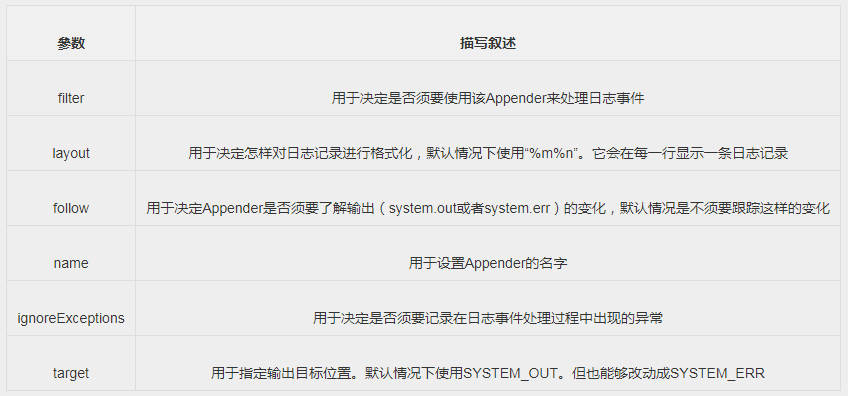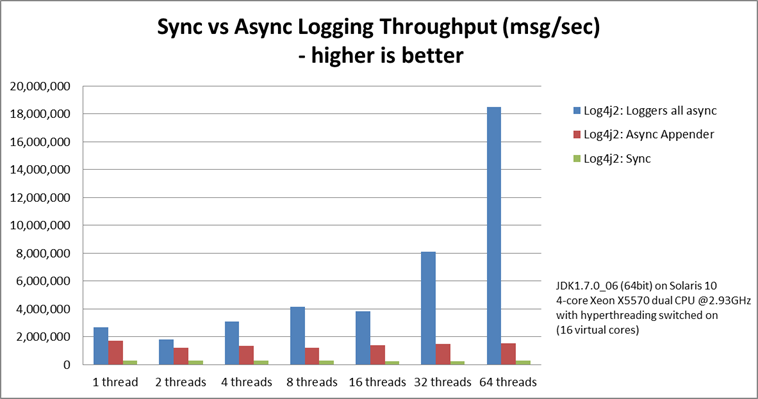| 编辑推荐: |
| 本文来自于个人博客,本文主要介绍了分布式环境须要实时分析统计的日志,一般採用apache
flume、facebook scribe等分布式日志收集系统,希望对您的学习有所帮助。 |
|
1、概述
眼下java应用日志收集都是採用日志框架(slf4j、apache
commons logging)+日志系统(log4j、log4j2、LogBack、JUL等)的方式。
日志框架:提供日志调用的接口,实际的日志输出托付给日志系统实现。
JCL(Jakarta Commons Logging):比較流行的日志框架,非常多框架都依赖JCL,比如Spring等。
SLF4j:提供新的API,初衷是配合Logback使用,但同一时候兼容Log4j。
日志系统:负责输出日志
Log4j:经典的一种日志解决方式。内部把日志系统抽象封装成 Logger
、appender 、pattern 等实现。我们能够通过配置文件轻松的实现日志系统的管理和多样化配置。
Log4j2:Log4j的2.0版本号。对Log4j进行了优化。比方支持參数API、支持异步appender、插件式架构等
Logback:Log4j的替代产品。须要配合日志框架SLF4j使用
JUL(java.util.logging):JDK提供的日志系统。较混乱,不经常使用
眼下我们的应用大部分都是使用了SLF4j作为门面,然后搭配log4j或者log4j2日志系统。


以下将介绍slf4j + Log4j2 日志组件的引入、以及配置和使用
2、Maven依赖
</pre><pre
name="code" class="html"><dependency>
<groupId>org.slf4j</groupId>
<artifactId>slf4j-api</artifactId>
<version>1.7.13</version>
</dependency>
<dependency>
<groupId>org.apache.logging.log4j</groupId>
<artifactId>log4j-slf4j-impl</artifactId>
<version>2.4.1</version>
</dependency>
<!--兼容log4j-->
<dependency>
<groupId>org.apache.logging.log4j</groupId>
<artifactId>log4j-1.2-api</artifactId>
<version>2.0</version>
</dependency>
<dependency>
<groupId>org.apache.logging.log4j</groupId>
<artifactId>log4j-api</artifactId>
<version>2.4.1</version>
</dependency>
<dependency>
<groupId>org.apache.logging.log4j</groupId>
<artifactId>log4j-core</artifactId>
<version>2.4.1</version>
</dependency>
<!--log4j2 异步appender须要-->
<dependency>
<groupId>com.lmax</groupId>
<artifactId>disruptor</artifactId>
<version>3.2.0</version>
</dependency>
|
3、配置
Appenders:也被称为Handlers。负责将日志事件记录到目标位置。在将日志事件输出之前,Appenders使用Layouts来对事件进行格式化处理。
Layouts:也被称为Formatters,它负责对日志事件中的数据进行转换和格式化。Layouts决定了数据在一条日志记录中的终于形式。
Loggers:Logger负责捕捉事件并将其发送给合适的Appender。
当Logger记录一个事件时。它将事件转发给适当的Appender。
然后Appender使用Layout来对日志记录进行格式化,并将其发送给控制台、文件或者其他目标位置。另外。Filters能够让你进一步指定一个Appender能否够应用在一条特定的日志记录上。在日志配置中,Filters并非必需的,但能够让你更灵活地控制日志消息的流动。
3.1 Appender
3.1.1 ConsoleAppender
ConsoleAppender是最经常使用的Appenders之中的一个。它仅仅是将日志消息显示到控制台上。
很多日志框架都将其作为默认的Appender。而且在主要的配置中进行预配置。
比如,在Log4j中ConsoleAppender的配置參数例如以下所看到的。

<Console
name="Console" target="SYSTEM_OUT">
<!--控制台仅仅输出level及以上级别的信息(onMatch)。其它的直接拒绝(onMismatch)-->
<ThresholdFilter level="DEBUG" onMatch="ACCEPT"
onMismatch="DENY"/>
<!--这个都知道是输出日志的格式-->
<PatternLayout pattern="%d{HH:mm:ss.SSS}
%-5level %class{36} %L %M - %msg%xEx%n"/>
</Console> |
3.1.2 FileAppender
FileAppenders将日志记录写入到文件里。它负责打开、关闭文件。向文件里追加日志记录,并对文件进行加锁。以免数据被破坏或者覆盖。
在Log4j中,假设想创建一个FileAppender,须要指定目标文件的名字。写入方式是追加还是覆盖。以及是否须要在写入日志时对文件进行加锁:
<File name="File"
fileName="fileAppender.log" append="true"
locking="true">
<PatternLayout
pattern="%d{HH:mm:ss.SSS} %-5level %class{36}
%L %M - %msg%xEx%n"/>
</File>
|
3.1.3 RollingFileAppender
RollingFileAppender跟FileAppender的基本使用方法一样。
但RollingFileAppender能够设置log文件的size(单位:KB/MB/GB)上限、数量上限,当log文件超过设置的size上限,会自己主动被压缩。
RollingFileAppender能够理解为滚动输出日志,假设log4j 2记录的日志达到上限,旧的日志将被删除,腾出的空间用于记录新的日志。
<!--这个会打印出全部的信息。每次大小超过size,则这size大小的日志会自己主动存入按年份-月份建立的目录以下并进行压缩,作为存档-->
<RollingFile
name="RollingFile1" fileName="logs/log1.log"
filePattern="logs/$${date:yyyy-MM}/log-%d{MM-dd-yyyy}-%i.log">
<PatternLayout pattern="%d{yyyy-MM-dd
'at' HH:mm:ss z} %-5level %class{36} %L %M - %msg%xEx%n"/>
<SizeBasedTriggeringPolicy size="100MB"/>
</RollingFile>
3.1.5 其它appende |
3.1.5 其它appender
我们已经介绍了一些经经常使用到的Appenders,还有非常多其他Appender。
它们加入了新功能或者在其他的一些Appender基础上实现了新功能。比如,Log4j中的RollingFileAppender扩展了FileAppender。它能够在满足特定条件时自己主动创建新的日志文件。SMTPAppender会将日志内容以邮件的形式发送出去;FailoverAppender会在处理日志的过程中,假设一个或者多个Appender失败,自己主动切换到其他Appender上。
假设想了解其它能够參考:https://logging.apache.org/log4j/
2.0 / manual / appenders.html
3.2 Layouts
Layouts将日志记录的内容从一种数据形式转换成第二种。日志框架为纯文本、HTML、syslog、XML、JSON、序列化以及其他日志提供了Layouts。
这里贴一篇文章简介下我们经常使用的 PatternLayout :
http ://wiki.jikexueyuan.com/project/log4j/log4j-patternlayout
. html
其它的layouts配置能够參考:https://logging.apache.org/log4j/2.0/manual/layouts.html
<PatternLayout pattern= "%d{yyyy-MM-dd
'at ' HH:mm:ss z } % - 5level % class { 36 } %L %M
- % msg%xEx%n " / >
3.3 Loggers
Logger负责捕捉事件并将其发送给合适的Appender。Logger之间是有继承关系的。
总是存在一个rootLogger,即使没有显示配置也是存在的,而且默认输出级别为DEBUG。其他的logger都继承自这个rootLogger。
Log4J中的继承关系是通过名称能够看出来,如"A"、"A.B"、"A.B.C",A.B继承A。A.B.C继承A.B,比較类似于包名。
<loggers>
<logger name="com.sankuai" level="info"
includeLocation="true" additivity="true">
<appender-ref ref="RollingFile2"/>
<appender-ref ref="RollingFile1"/>
</logger>
<logger name="com.sankuai.meituan"
level="error" includeLocation="true"
additivity="true">
<appender-ref
ref="RollingFile2"/>
<appender-ref
ref="RollingFile1"/>
</logger>
<!--建立一个默认的root的logger-->
<root level="error">
<appender-ref ref="Console"/>
<appender-ref ref="RollingFile1"/>
</root>
</loggers> |
additivity是 子Logger 是否继承 父Logger 的 输出源(appender) 的标志位。详细说,默认情况下
子Logger 会继承 父Logger 的appender,也就是说 子Logger 会在 父Logger
的appender里输出。若是additivity设为false,则 子Logger 仅仅会在自己的appender里输出。而不会在
父Logger 的appender里输出。
3.4 日志级别
DEBUG , INFO ,WARN ,ERROR四种,分别相应Logger类的四种方法
debug(Object message ) ;
info(Object message ) ;
warn(Object message ) ;
error(Object message ) ;
假设设置级别为INFO。则优先级大于等于INFO级别(如:INFO、WARN、ERROR)的日志信息将能够被输出,
小于该级别的如:DEBUG将不会被输出
4、Log4j2 AsyncLogger与AsyncAppender
先上图


第一张图能够看出Log4j2的asyncLogger的性能较使用asyncAppender和sync模式有很大的提升。特别是线程越多的时候。
第二张图是将log4j2的异步日志机制和其它日志系统进行对照,log4j2的asyncLogger
性能也是非常有优势。
这里主要涉及了两个概念AsyncLogger和AysncAppender。是支持异步的Logger和Appender,以下分别简要介绍下这两个概念。
4.1 AsyncAppender
AsyncAppender持有其它的配置了aysnc的appender引用列表(appender须要通过配置注冊成异步的)。当其它的logger须要打日志的时候(logEvent事件),asyncAppender会接收logEvent,缓存到queue中,然后用单独的线程完毕从queue中取logEvent打印到目的appender,这个逻辑比較简单,看下源代码就能明确这个流程。ps.
AsyncAppender是Log4j 和Log4j2 都有的,不是新东西,但从上面的性能对照上还是有一点点差异的。基本的原因是:(引用官方说法)
Asynchronous Appenders already existed in Log4j 1.x
, but have been enhanced to flush to disk at the end
of a batch (when the queue is empty ) .
关于AsyncAppender能提高性能的场景。能够看下这个篇文章。
http : // littcai . iteye . com /
blog / 316605
怎样配置一个AsyncAppender:
<?xml version="1.0"
encoding="UTF-8"?>
<Configuration status="warn" name="MyApp"
packages="">
<Appenders>
<File name="MyFile" fileName="logs/app.log">
<PatternLayout>
<Pattern>%d %p
%c{1.} [%t] %m%n</Pattern>
</PatternLayout>
</File>
<Async name="Async">
<AppenderRef ref="MyFile"/>
</Async>
</Appenders>
<Loggers>
<Root level="error">
<AppenderRef
ref="Async"/>
</Root>
</Loggers>
</Configuration>
@Plugin(name = "Async", category
= "Core", elementType = "appender",
printObject = true)
public final class AsyncAppender extends AbstractAppender
{
private static final long serialVersionUID =
1L;
private static final int DEFAULT_QUEUE_SIZE
= 128;
private static final String SHUTDOWN = "Shutdown";
private static final AtomicLong THREAD_SEQUENCE
= new AtomicLong(1);
private static ThreadLocal<Boolean> isAppenderThread
= new ThreadLocal<>();
private final BlockingQueue<Serializable>
queue;
private final int queueSize;
private final boolean blocking;
private final long shutdownTimeout;
private final Configuration config;
private final AppenderRef[] appenderRefs;
private final String errorRef;
private final boolean includeLocation;
private AppenderControl errorAppender;
private AsyncThread thread;
private AsyncAppender(final String name, final
Filter filter, final AppenderRef[] appenderRefs,
final String errorRef, final int queueSize,
final boolean blocking, final boolean ignoreExceptions,
final long shutdownTimeout, final Configuration
config, final boolean includeLocation) {
super(name, filter, null, ignoreExceptions);
this.queue = new ArrayBlockingQueue<>(queueSize);
this.queueSize = queueSize;
this.blocking = blocking;
this.shutdownTimeout = shutdownTimeout;
this.config = config;
this.appenderRefs = appenderRefs;
this.errorRef = errorRef;
this.includeLocation = includeLocation;
}
@Override
public void start() {
final Map<String, Appender> map = config.getAppenders();
final List<AppenderControl> appenders
= new ArrayList<>();
for (final AppenderRef appenderRef : appenderRefs)
{
final Appender appender = map.get(appenderRef.getRef());
if (appender != null) {
appenders.add(new AppenderControl(appender,
appenderRef.getLevel(), appenderRef.getFilter()));
} else {
LOGGER.error("No appender named {} was
configured", appenderRef);
}
}
if (errorRef != null) {
final Appender appender = map.get(errorRef);
if (appender != null) {
errorAppender = new AppenderControl(appender,
null, null);
} else {
LOGGER.error("Unable to set up error Appender.
No appender named {} was configured", errorRef);
}
}
if (appenders.size() > 0) {
thread = new AsyncThread(appenders, queue);
thread.setName("AsyncAppender-" +
getName());
} else if (errorRef == null) {
throw new ConfigurationException("No appenders
are available for AsyncAppender " + getName());
}
thread.start();
super.start();
}
@Override
public void stop() {
super.stop();
LOGGER.trace("AsyncAppender stopping. Queue
still has {} events.", queue.size());
thread.shutdown();
try {
thread.join(shutdownTimeout);
} catch (final InterruptedException ex) {
LOGGER.warn("Interrupted while stopping
AsyncAppender {}", getName());
}
LOGGER.trace("AsyncAppender stopped. Queue
has {} events.", queue.size());
}
/**
* Actual writing occurs here.
*
* @param logEvent The LogEvent.
*/
@Override
public void append(LogEvent logEvent) {
if (!isStarted()) {
throw new IllegalStateException("AsyncAppender
" + getName() + " is not active");
}
if (!(logEvent instanceof Log4jLogEvent)) {
if (!(logEvent instanceof RingBufferLogEvent))
{
return; // only know how to Serialize Log4jLogEvents
and RingBufferLogEvents
}
logEvent = ((RingBufferLogEvent) logEvent).createMemento();
}
logEvent.getMessage().getFormattedMessage();
// LOG4J2-763: ask message to freeze parameters
final Log4jLogEvent coreEvent = (Log4jLogEvent)
logEvent;
boolean appendSuccessful = false;
if (blocking) {
if (isAppenderThread.get() == Boolean.TRUE &&
queue.remainingCapacity() == 0) {
// LOG4J2-485: avoid deadlock that would result
from trying
// to add to a full queue from appender thread
coreEvent.setEndOfBatch(false); // queue is
definitely not empty!
appendSuccessful = thread.callAppenders(coreEvent);
} else {
final Serializable serialized = Log4jLogEvent.serialize(coreEvent,
includeLocation);
try {
// wait for free slots in the queue
queue.put(serialized);
appendSuccessful = true;
} catch (final InterruptedException e) {
// LOG4J2-1049: Some applications use Thread.interrupt()
to send
// messages between application threads. This
does not necessarily
// mean that the queue is full. To prevent dropping
a log message,
// quickly try to offer the event to the queue
again.
// (Yes, this means there is a possibility the
same event is logged twice.)
//
// Finally, catching the InterruptedException
means the
// interrupted flag has been cleared on the
current thread.
// This may interfere with the application's
expectation of
// being interrupted, so when we are done, we
set the interrupted
// flag again.
appendSuccessful = queue.offer(serialized);
if (!appendSuccessful) {
LOGGER.warn("Interrupted while waiting
for a free slot in the AsyncAppender LogEvent-queue
{}",
getName());
}
// set the interrupted flag again.
Thread.currentThread().interrupt();
}
}
} else {
appendSuccessful = queue.offer(Log4jLogEvent.serialize(coreEvent,
includeLocation));
if (!appendSuccessful) {
error("Appender " + getName() + "
is unable to write primary appenders. queue
is full");
}
}
if (!appendSuccessful && errorAppender
!= null) {
errorAppender.callAppender(coreEvent);
}
}
/**
* Create an AsyncAppender.
*
* @param appenderRefs The Appenders to reference.
* @param errorRef An optional Appender to write
to if the queue is full or other errors occur.
* @param blocking True if the Appender should
wait when the queue is full. The default is
true.
* @param shutdownTimeout How many milliseconds
the Appender should wait to flush outstanding
log events
* in the queue on shutdown. The default is zero
which means to wait forever.
* @param size The size of the event queue. The
default is 128.
* @param name The name of the Appender.
* @param includeLocation whether to include
location information. The default is false.
* @param filter The Filter or null.
* @param config The Configuration.
* @param ignoreExceptions If {@code "true"}
(default) exceptions encountered when appending
events are logged;
* otherwise they are propagated to the caller.
* @return The AsyncAppender.
*/
@PluginFactory
public static AsyncAppender createAppender(@PluginElement("AppenderRef")
final AppenderRef[] appenderRefs,
@PluginAttribute("errorRef") @PluginAliases("error-ref")
final String errorRef,
@PluginAttribute(value = "blocking",
defaultBoolean = true) final boolean blocking,
@PluginAttribute(value = "shutdownTimeout",
defaultLong = 0L) final long shutdownTimeout,
@PluginAttribute(value = "bufferSize",
defaultInt = DEFAULT_QUEUE_SIZE) final int size,
@PluginAttribute("name") final String
name,
@PluginAttribute(value = "includeLocation",
defaultBoolean = false) final boolean includeLocation,
@PluginElement("Filter") final Filter
filter, @PluginConfiguration final Configuration
config,
@PluginAttribute(value = "ignoreExceptions",
defaultBoolean = true) final boolean ignoreExceptions)
{
if (name == null) {
LOGGER.error("No name provided for AsyncAppender");
return null;
}
if (appenderRefs == null) {
LOGGER.error("No appender references provided
to AsyncAppender {}", name);
}
return new AsyncAppender(name, filter, appenderRefs,
errorRef, size, blocking, ignoreExceptions,
shutdownTimeout, config, includeLocation);
}
/**
* Thread that calls the Appenders.
*/
private class AsyncThread extends Thread {
private volatile boolean shutdown = false;
private final List<AppenderControl> appenders;
private final BlockingQueue<Serializable>
queue;
public AsyncThread(final List<AppenderControl>
appenders, final BlockingQueue<Serializable>
queue) {
this.appenders = appenders;
this.queue = queue;
setDaemon(true);
setName("AsyncAppenderThread" + THREAD_SEQUENCE.getAndIncrement());
}
@Override
public void run() {
isAppenderThread.set(Boolean.TRUE); // LOG4J2-485
while (!shutdown) {
Serializable s;
try {
s = queue.take();
if (s != null && s instanceof String
&& SHUTDOWN.equals(s.toString())) {
shutdown = true;
continue;
}
} catch (final InterruptedException ex) {
break; // LOG4J2-830
}
final Log4jLogEvent event = Log4jLogEvent.deserialize(s);
event.setEndOfBatch(queue.isEmpty());
final boolean success = callAppenders(event);
if (!success && errorAppender != null)
{
try {
errorAppender.callAppender(event);
} catch (final Exception ex) {
// Silently accept the error.
}
}
}
// Process any remaining items in the queue.
LOGGER.trace("AsyncAppender.AsyncThread
shutting down. Processing remaining {} queue
events.",
queue.size());
int count = 0;
int ignored = 0;
while (!queue.isEmpty()) {
try {
final Serializable s = queue.take();
if (Log4jLogEvent.canDeserialize(s)) {
final Log4jLogEvent event = Log4jLogEvent.deserialize(s);
event.setEndOfBatch(queue.isEmpty());
callAppenders(event);
count++;
} else {
ignored++;
LOGGER.trace("Ignoring event of class {}",
s.getClass().getName());
}
} catch (final InterruptedException ex) {
// May have been interrupted to shut down.
// Here we ignore interrupts and try to process
all remaining events.
}
}
LOGGER.trace("AsyncAppender.AsyncThread
stopped. Queue has {} events remaining. "
+ "Processed {} and ignored {} events since
shutdown started.", queue.size(), count,
ignored);
}
/**
* Calls {@link AppenderControl#callAppender(LogEvent)
callAppender} on all registered {@code AppenderControl}
* objects, and returns {@code true} if at least
one appender call was successful, {@code false}
otherwise. Any
* exceptions are silently ignored.
*
* @param event the event to forward to the registered
appenders
* @return {@code true} if at least one appender
call succeeded, {@code false} otherwise
*/
boolean callAppenders(final Log4jLogEvent event)
{
boolean success = false;
for (final AppenderControl control : appenders)
{
try {
control.callAppender(event);
success = true;
} catch (final Exception ex) {
// If no appender is successful the error appender
will get it.
}
}
return success;
}
public void shutdown() {
shutdown = true;
if (queue.isEmpty()) {
queue.offer(SHUTDOWN);
}
}
}
/**
* Returns the names of the appenders that this
asyncAppender delegates to as an array of Strings.
*
* @return the names of the sink appenders
*/
public String[] getAppenderRefStrings() {
final String[] result = new String[appenderRefs.length];
for (int i = 0; i < result.length; i++) {
result[i] = appenderRefs[i].getRef();
}
return result;
}
/**
* Returns {@code true} if this AsyncAppender
will take a snapshot of the stack with every
log event to determine
* the class and method where the logging call
was made.
*
* @return {@code true} if location is included
with every event, {@code false} otherwise
*/
public boolean isIncludeLocation() {
return includeLocation;
}
/**
* Returns {@code true} if this AsyncAppender
will block when the queue is full, or {@code
false} if events are
* dropped when the queue is full.
*
* @return whether this AsyncAppender will block
or drop events when the queue is full.
*/
public boolean isBlocking() {
return blocking;
}
/**
* Returns the name of the appender that any
errors are logged to or {@code null}.
*
* @return the name of the appender that any
errors are logged to or {@code null}
*/
public String getErrorRef() {
return errorRef;
}
public int getQueueCapacity() {
return queueSize;
}
public int getQueueRemainingCapacity() {
return queue.remainingCapacity();
}
}
|
AsyncLogger是Log4j2引入的新特性,业务代码调用Logger.log的时候直接返回。而不须要等到appender输出到日志目的地后才返回。
Log4j2 的 Asynclogger 是通过 LMAX Disruptor
取代queue实现的异步(无锁的并发框架,http://ifeve.com/disruptor/。Disruptor
简单介绍),达到更高的并发和 lower latency。
4.2 AsyncLogger
1,Disruptor使用了一个RingBuffer替代队列,用生产者消费者指针替代锁。
2,生产者消费者指针使用CPU支持的整数自增。无需加锁而且速度非常快。Java的实如今
Unsafe package中。
虽然AsyncLogger 可以大幅度的提高性能。可是也会带来一些问题。以下是翻译官方的文档的Trade-offs:
Benefits
Higher throughput,达到相对于sync logger的6-68倍的吞吐量
Lower logging latency,latency是调用Logger.log直到return的时间。asyncLogger的latency比syncLogger以及基于queue的aysncAppender都要低,不仅平均latency低,并且99%、95%latency
也都低于后两者
减少极端大的日志量时候的延迟尖峰
Drawbacks
Error handling, 假设在打印日志的时候出现错误,使用asyncLogger。业务是不知道异常的(能够通过配置ExceptionHandler处理异常)。假设打印日志是业务逻辑的一部分,不建议使用asyncLogger
打印一些可变的内容的时候。使用asyncLogger 会出现故障。大部分时间,不须要操心这点。Log4j确保了类似于
logger.debug("My object is {}", myObject),使用myObject在打印日志的时刻的版本号打印(Log4j
全部打印都日志都是封装到Message的实现类里,存储在 final String里),无论之后是否改变。可是log4j也支持一些了可变的Message,如
MapMessage and StructuredDataMessage 。这些假设在打印日志时候改变,就有问题了
全局配置异步Logger
配置全部Logger都为AsyncLogger,仅仅须要添加disruptor包,然后配置一个
system property ,-DLog4jContextSelector = org .apache
.logging .log4j .core .async .AsyncLoggerContextSelector
。Log4j的配置文件不须要改动。
混合使用同步和异步Logger
单独配置某个logger为async的,通过<asyncRoot>或者<asyncLogger>
<Configuration
status="WARN">
<Appenders>
<!-- Async Loggers will auto-flush in batches,
so switch off immediateFlush. -->
<RandomAccessFile
name="RandomAccessFile" fileName="asyncWithLocation.log"
immediateFlush="false" append="false">
<PatternLayout>
<Pattern>%d %p
%class{1.} [%t] %location %m %ex%n</Pattern>
</PatternLayout>
</RandomAccessFile>
</Appenders>
<Loggers>
<!--
pattern layout actually uses location, so we need
to include it -->
<AsyncLogger name="com.foo.Bar"
level="trace" includeLocation="true">
<AppenderRef ref="RandomAccessFile"/>
</AsyncLogger>
<Root level="info"
includeLocation="true">
<AppenderRef
ref="RandomAccessFile"/>
</Root>
</Loggers>
</Configuration> |
ps. location的问题
当layouts配置了输出%C or $class, %F or %file, %l or %location,
%L or %line, %M or %method,或者HTML locationInfo, log4j会获取location的一个快照,而这对于sync
和async的logger都是一个耗时的操作(官方文档上说syncLogger会慢1.3~5倍。async会慢4-20倍)。所以默认都是不会输出location信息,除非Logger配置了includeLocation="true"(官方文档这么说的,可是我測试的是默认是输出的,无论了。反正当日志出现慢的时候,能够考虑通过配置includeLocation控制是否输出location信息)。
|